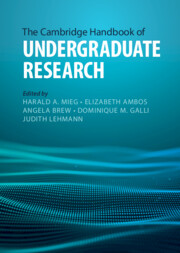Book contents
- The Cambridge Handbook of Undergraduate Research
- The Cambridge Handbook of Undergraduate Research
- Copyright page
- Contents
- Figures
- Tables
- Contributors
- Foreword
- Foreword
- 1 Introduction
- Part I Theory and Research on Undergraduate Research
- Part II Implementation, Approaches, Methods
- Part III Disciplines
- Part IV International Perspective
- 47 Introduction
- Part IV.1 Americas
- Part IV.2 Africa & Middle East
- 54 Undergraduate Research in South Africa
- 55 Undergraduate Research in Nigeria
- 56 Undergraduate Research in Israel
- 57 Undergraduate Research in the United Arab Emirates
- Part IV.3 Asia & Oceania
- Part IV.4 Europe
- Part V Avenues for Developing Undergraduate Research
- Index
- References
54 - Undergraduate Research in South Africa
Understanding the Quandary
from Part IV.2 - Africa & Middle East
Published online by Cambridge University Press: 11 August 2022
- The Cambridge Handbook of Undergraduate Research
- The Cambridge Handbook of Undergraduate Research
- Copyright page
- Contents
- Figures
- Tables
- Contributors
- Foreword
- Foreword
- 1 Introduction
- Part I Theory and Research on Undergraduate Research
- Part II Implementation, Approaches, Methods
- Part III Disciplines
- Part IV International Perspective
- 47 Introduction
- Part IV.1 Americas
- Part IV.2 Africa & Middle East
- 54 Undergraduate Research in South Africa
- 55 Undergraduate Research in Nigeria
- 56 Undergraduate Research in Israel
- 57 Undergraduate Research in the United Arab Emirates
- Part IV.3 Asia & Oceania
- Part IV.4 Europe
- Part V Avenues for Developing Undergraduate Research
- Index
- References
Summary
There are concerns that the South African higher education system is not producing sufficient graduates to meet national needs in respect of economic and social development. Systemic reform such as strengthening the undergraduate teaching and research relationship, which is inextricably tied to curriculum structure, is necessary to meet the goals of equity and development and enhancing graduate quality. This can potentially widen the pipeline into postgraduate studies and produce the next generation of academics. The main argument of this chapter is the need to profoundly change the manner in which teaching is structured in South Africa, in order to shift the prevailing culture of undergraduate students as receivers to one in which they are inquirers. This requires pedagogies that enable inquiry-led learning to be developed, to actively engage students in the research process and for them to make the linkage to their discipline-specific practice. An increased focus on building an undergraduate research culture through pedagogical reforms is still needed.
Keywords
- Type
- Chapter
- Information
- The Cambridge Handbook of Undergraduate Research , pp. 499 - 507Publisher: Cambridge University PressPrint publication year: 2022

